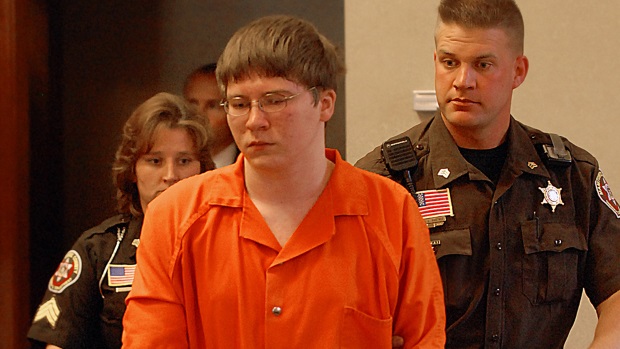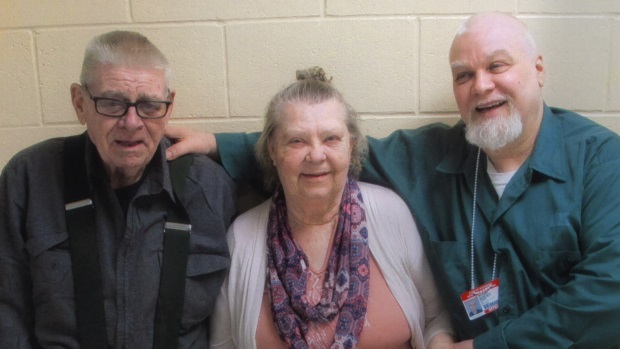Making a Murderer Season 2: Creators Discuss Cautionary Tale
Making A Murderer co-director Laura Ricciardi on Steven Avery and Brendan Dassey and the possibility of a season 3
The following contains spoilers for Making a Murderer Season 2.
This article comes from Den of Geek UK.
“I refer to it as a cautionary tale!” laughs Laura Ricciardi, one half of the team (with Moira Demos) who created Netflix sensation Making a Murderer – a project that spanned more than a decade with no guarantee, at the outset, of the show ever being broadcast at all. A cautionary tale that paid off, then.
“We hope our project can be an example for emerging filmmakers, emerging artists in general, and just people in general because we did take a leap of faith but I really believed in Moira.
“I think that after we’d gone out and sort of explored the idea of maybe following the story for about a week, we thought it was a once-in-a-lifetime opportunity, and as two thirty-something women, we felt like it’s important for us to create an opportunity for ourselves.”
Recent film graduates, the two heard about the amazing story of Steven Avery, a man convicted of a violent rape who served 18 years in prison before DNA evidence exonerated him. If you’ve not seen season one and two of the show, stop reading now and go watch. Spoilers to follow.
further reading: Best Documentaries on Netflix
The story just gets stranger from here.
Still here? OK…
If you’ve watched season one you’ll know that at the end Avery and Dassey are incarcerated, though season two sees both hire teams of tenacious lawyers to work on their cases. Avery in fact, managed to hire Kathleen Zellner, an attorney famous for her success in wrongful conviction cases having obtained exonerations in 19 cases, while Dassey bagged Steven Drizin and Laura Nirider. Season two follows their lawyers’ attempts to get Dassey’s conviction overturned and Avery to get a retrial.
Den of Geek sat down with Riccardi to talk about the ethical implications of the show, staying impartial and whether there could be a Making a Murderer Season 3.
Obviously, the first season hit and was enormous. How did the experience of shooting season 2 differ from the first one?
That’s a great question that I’ve been thinking a lot about recently. One obvious way that it differed was that we had a partner from the outset. We had a partner in Netflix – a pretty great partner to have. And so, you know, with the financing from the outset, we were able to hire a crew.
For a season, it was me and maybe two of us, and certainly we like to say it’s a family project. My younger sister lived in Chicago at the time, just a few hours’ drive from Manitowoc. She helped quite a bit.
But this season, we were in production and editorial simultaneously. The first season, it was different. We relocated from New York City to Manitowoc, because we had time. We didn’t have any money, but we had time, and we thought that we could sublet our apartment in New York, relocate to Manitowoc, where the cost of living is a lot lower, and just invest the time that we need to tell the story properly.
And then after about 18 months of following the story on the ground, we moved back to New York City, and went back to day jobs, and got into the editorial process then.
How did the fact that the case has now become incredibly famous affect part two? Was it a blessing or a curse?
I don’t think it hindered our process in any way, actually. I think that what we appreciate is that people are still interested in the story. I think, frankly, that’s something that Netflix had to think about, and that we had to think about.
Because when the series launched, there was such a tremendous response. Moira and I know our process. We know that it takes time to tell the story in the way that we want to, and to do the story justice.
And also, it was very open-ended. We had no idea: would there be many events to document? Would Steven, or would Brendan, get another day in court? There was just no way of knowing. But we had confidence that viewers would be interested in seeing more, even if it took some time. You want the material to feel timely as well.
So I think, before, we were feeling like: “This type of story to us feels timeless.” So there’s this question of: “Can it be timeless and timely all at the same time?”
Were the ethical issues different from season two than they were for season one? We’re thinking about things like Ken Kratz getting death threats, and Teresa Halbach’s family now being much more in the public eye.
In telling a story as documentarians, we certainly feel a tremendous responsibly to our subjects, whether they’re people we’ve sat down with directly or just people we’re showing – whether it’s archival footage, or footage of what they were doing publically.
So there is a rigor to our process, and we really take a deep dive. We do a tremendous amount of research and fact-checking and try to use primary source materials – as much as those are available to us. So we try to go directly to the source.
further reading: The Best True Crime Series Available to Watch Right Now
And we think that that has creative benefits as well, because we wanted the experience to be experiential for viewers. And the more that you can use primary source materials, I think the more it feels like the viewer is in the interrogation room with Brendan Dassey or in the courtroom with Steven Avery.
And to answer your question about the Halbachs, for instance – we reached out to them, both for part one and part two, to invite them to participate. They declined, and we absolutely respect that. They don’t owe us anything.
But we think that regardless of whether or not they directly participated, our job is to just try to tell the story as responsibly as we can.

It must be difficult to stay impartial, because you’ve known these people for more than a decade…
Yeah, it’s not a question of partiality or impartiality. We don’t take a position on what we’re covering, but at the same time, we have developed relationships with our subjects. We’re documentarians. We’re living in the community with them, and we had a tremendous amount of empathy for them.
Because the main reason that we chose to Steven Avery’s story – it’s not as though we were mining for a good murder story. We weren’t at all. We were graduate film students at the time, and it really fell into our laps. He appeared on the front page of the New York Times, and we thought, this just seems like an incredible story, because this person is uniquely situated as a DNA exonerate charged in a new crime.
And we thought, we want to go back and try to set up the historical context for this new case that we can be on the ground for, documenting as it’s unfolding.
And really, to put the system to the test. Because we were reading that there had been scientific advances and legislative reforms, and that the system really had improved since 1985. When Steven was rearrested, 20 years had transpired since his wrongful conviction. So we really believed it was a once-in-a-lifetime opportunity to tell the story of someone with such a unique status.
Kathleen Zellner has now come on for this. How did you feel when you found out that she was going to take the case? What has that brought to this new series?
Steven’s trial attorneys represented him through his sentencing in 2007. Then he was represented by state appointed public defenders when he went through his first post-conviction in the public process. And by 2011, he lost all the attorneys.
So he was representing himself, and we show that at the end of part one. And you know, Steven is, at best, semi-literate, and so the idea of him trying to comb through his case file and file motions with the court and try to get another day in court, was really the ultimate underdog story.
So to find out that the winningest private post-conviction attorney in the country decided to take his case? We really wanted to point a camera at that, and to watch her work, essentially, and to see what it would be like to watch a post-conviction attorney challenge her client’s conviction and life sentence.
That’s amazing. So how’s it been for the Avery family since the first season came out? How has that media attention been for them? How has it changed things?
You know, it’s interesting. I think that it’s changed things in obvious ways. In part one, there’s a scene where we show Mrs. Avery in her living room with her daughter Barb and her son Chuck, and they’re reading through hate mail, essentially, and horrible things that people wrote, like ‘Your son is a murderer’. They were letters people were writing to Mrs. Avery, telling her to shut up, basically, because she had spoken out in the local media, saying, ‘My son is innocent.’
So to document that back in 2006, pre-launch, and post-launch, after 2015, to be back in that same house with Mrs. Avery and to see her go through a box of so-called ‘love’ mail? We really felt, in certain ways, that we’re documenting a new world.
But the reality is that we also wanted to turn a lens on the status of the business, the Avery Salvage Yard, because everyone in the family, that’s their livelihood. So we really wanted to see: is the change really just about emotional support, or does it have – I don’t know – other meanings? Does it translate into something otherwise meaningful for them?

After the first season, there were articles saying bits and pieces of evidence weren’t shown in the first series. Can you talk to us a bit about that?
Sure. From our perspective, there were things that just didn’t make the cut. It was a 10-episode season, but we probably had about a thousand hours of footage. The things that have been pointed to… you know, we really believed that we were putting in the state’s best evidence, and as storytellers, that’s what you want to do. You don’t want to undermine the conflict if you’re trying to tell a compelling story.
And then, of course, there are just the ethical considerations. We were trying to give our viewers an experience and trying to do that in the most responsible way.
By the end of the season it looks like Brendan isn’t getting out. Where next for Brendan? Do you think they will ever get out?
You know, it’s really difficult to say. I don’t know. Having taken Brendan’s case out of the state court system and moving it to the federal court system, Steve Drizin, one of Brendan’s lawyers, talks about how it would take a legal miracle to get his conviction overturned.
It makes me wonder why. How is the system designed? Is it set up for success? And if it is, why should it take a miracle?
But one of the things we explore in part two is this statute, this federal statute, that was this law that was enacted during the Clinton administration, and they trace the roots of it to the Oklahoma City bombing, and how legislation can grow out of something that members of Congress are reacting to – something horrific like this Oklahoma City bombing.
Interestingly, when we were doing our research, we were looking back to the US Supreme Court and at a time when William Rehnquist was the Chief Justice. At that time, he had appointed a judge, Justice Powell, to basically provide a report to Congress about the question of federalism. And what that means, basically, is the power of the federal courts to take a look at what the state courts have done – it’s a jurisdictional issue, in a way, and it has to do with… I think that Justice Rehnquist was really concerned about the workload, frankly, of the federal courts.
So to think about legislation that has touched, actually, all three branches of government, and to understand what the rationale or the motivation for passing it was – and you think, ‘Oh, it’s about efficiency, finality.’ It’s troubling, in a way, because taking someone’s liberty, their freedom, is a very serious matter. And especially when in a jurisdiction like Wisconsin, a sentence – a mandatory sentence – can be a life in prison. You would hope that there is a system that allows for a second look. I think what we see play out in part two, with Brendan’s case, is just the incredible challenge of trying to get the federal courts to look at the case. And then when they do, is that look meaningful? Laura and Steve, I think, would argue that the hands of the federal courts are tied.
One of the things I’m curious about is how viewers are going to respond to what they learn about this statute, and the way in which the two systems relate to one another. A major reason we wanted to do a second part was to examine the post-conviction process. What does it mean to be challenging your conviction, a life sentence? What’s in your way? What are the obstacles? What are the stakes? Is there any hope for your grievances to be redressed?
Could there be a Making a Murderer season 3? And if so, any thoughts on where that will take us?
Honestly, we don’t know. We are open, and I think it really depends— we’ll be asking the same questions that we did when we were considering doing a second part. What’s happening? Who’s involved? Do we have access? Is it something we can point a camera at?
I think part of it, too, would be: is there still an appetite for more of this story? So, we’ll see.
